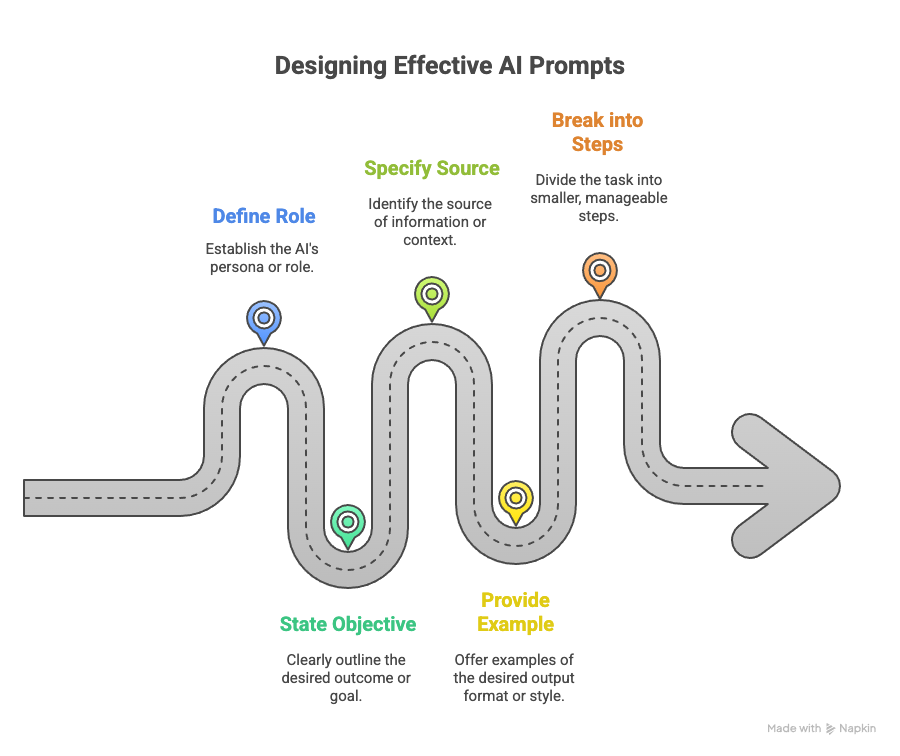ROSES framework for AI prompt design is an innovative approach to crafting effective prompts that maximize the capabilities of AI language models. As AI technology evolves, knowing how to communicate with these models to produce accurate, relevant, and creative outputs becomes essential. The ROSES framework offers a structured method to develop prompts that guide AI toward desired outcomes by focusing on five key elements: Role, Objective, Structure, Examples, and Style. This article will explore each of these components in detail, demonstrating how they collectively enhance prompt quality. Whether you’re a content creator, developer, or AI enthusiast, understanding ROSES will empower you to harness AI more efficiently and creatively, reducing ambiguous outputs and improving user experience.

Understanding the role
The first step in the ROSES framework is defining the role the AI should assume. By specifying a role, you set clear expectations for the kind of response you want. For example, instructing the AI to respond “as a professional editor” or “as a historical researcher” guides the tone, depth, and perspective of the output. Role definition minimizes vagueness and helps AI tailor answers more specifically, ensuring alignment with user intent. This element is crucial because AI models generate results based on patterns learned from massive datasets; signaling a precise role focuses the model’s contextual understanding and relevance.
Clarifying the objective
Once the role is established, it’s important to outline the objective of the prompt. This clarifies the purpose behind the AI’s response, making the task explicit. Objectives can range from summarizing content, generating ideas, solving a problem, or providing detailed explanations. When an objective is clearly stated, the AI can prioritize information, optimize its internal processes to meet user needs, and avoid irrelevant or excessive output. This aspect acts as a compass, directing how the AI approaches the prompt and what to focus on.
Structuring prompts for clarity
Structure is the backbone of effective prompts. The ROSES framework encourages creating a clear and logical format within the prompt itself. This can include breaking down requests into steps, using bullet points, or explicitly defining the format of the desired response. Structured prompts help AI parse complex instructions better and reduce misunderstandings. For instance, asking for “a list of three benefits with explanations” rather than just “tell me the benefits” produces more organized results. Structure also aids in maintaining consistency when designing multiple prompts, which is critical for applications relying on repetitive AI interactions.
Using examples and defining style
Including examples in prompts serves as valuable guidance for AI, demonstrating the kind of answer or output expected. Examples can clarify tone, detail level, and format. Alongside examples, defining the style of writing or interaction — whether formal, conversational, technical, or creative — ensures the result fits the intended audience or purpose. The combination of examples and style instructions fine-tunes AI response nuances, reducing generic or inappropriate answers. Effective use of this step can elevate basic prompts into sophisticated commands that reflect precise human preferences.
| ROSES element | Description | Example directive |
|---|---|---|
| Role | Defines the perspective or identity AI should adopt | “Answer as a medical professional” |
| Objective | Specifies the goal of the prompt | “Summarize the main points” |
| Structure | Organizes expected content and format | “Provide a bulleted list with explanations” |
| Examples | Gives sample outputs to illustrate desired responses | “Example: ‘The benefits include…’” |
| Style | Sets the tone, complexity, and language style | “Use a friendly and conversational tone” |
Conclusion
The ROSES framework offers a comprehensive blueprint for designing AI prompts that are precise, relevant, and high-quality. By clearly defining the role, users establish the perspective from which the AI responds, reducing ambiguity. Specifying the objective ensures the purpose is clear, which helps focus the AI’s output. Thoughtful structuring of prompts aids clarity and consistency, while incorporating examples and style guidelines fine-tunes the tone and presentation of responses. Together, these elements foster more effective communication with AI models, leading to better usability and productivity. Whether you are fine-tuning chatbots, generating creative content, or automating workflows, applying the ROSES framework can significantly improve interaction outcomes and harness AI’s full potential.
